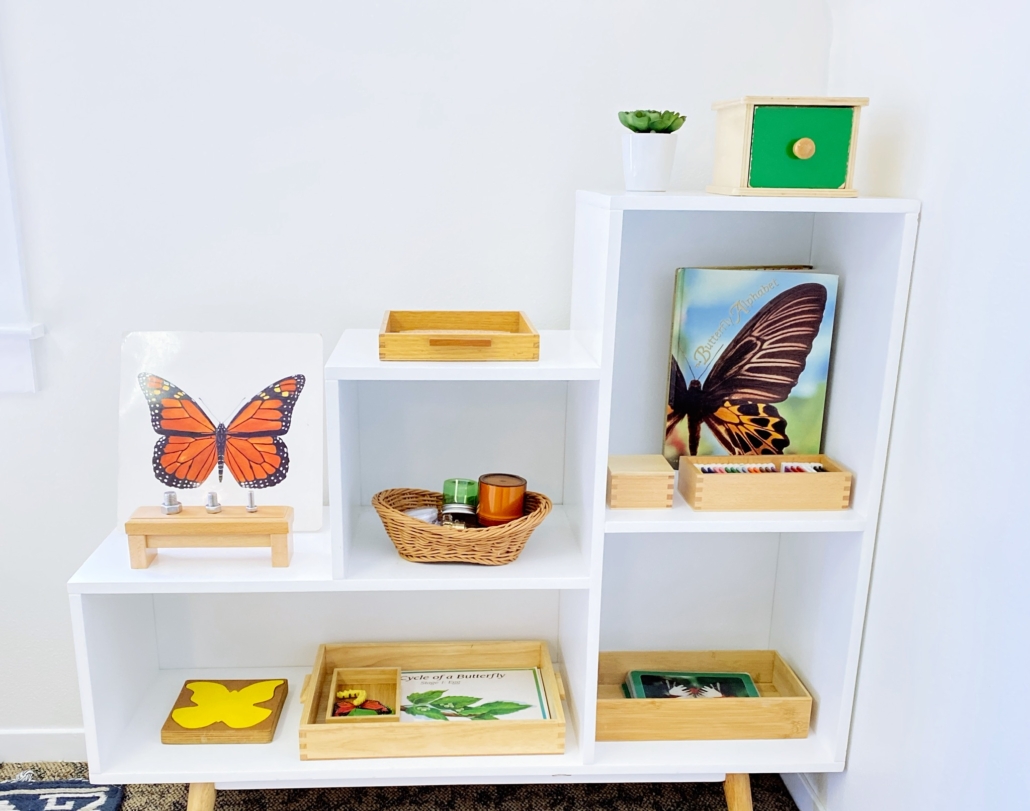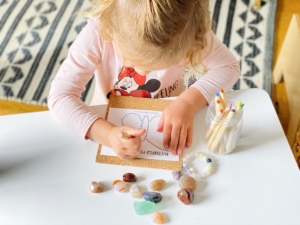 You should know right up front that Toddlers (children anywhere from 18 months-3 years) don’t really need shelf work! Yep! We said it! But hear us out.
You should know right up front that Toddlers (children anywhere from 18 months-3 years) don’t really need shelf work! Yep! We said it! But hear us out.
A Toddler’s work is to learn from his/her environment and master their gross motor skills. This means that they spend a lot of time in practical life work, large movement activities and hopefully outside.
This doesn’t at all mean that you shouldn’t do a shelf for your child. We love a good shelf! We create shelves for our children no matter their age. They are perfect for teaching organization and for simplicity. By providing activities for our toddlers on our shelves that are based on their interest and needs, we give them opportunities for learning a lot of things. But the truth of the matter is, for this age group, movement and practical life are where it’s at!
With this in mind, use the shelf for things like: blocks, cars, books, table setting work, 2-4 piece puzzles, balls, sensorial materials, matching work, figurines, letter baskets, etc. Introduce activities on your child’s shelf and model how to put things away when they are done. Everything has a place. Just don’t get super wrapped up in a toddler needing to perfectly execute the shelf because it just won’t happen.
No matter the age of your child, creating interest on their shelves is important. Even 3-6 year olds who naturally gravitate towards shelf work need inspiration. In this post, we will show you 8 steps that you can use to gently guide and encourage the use of the shelf with your toddler.
These steps do not have to be used and maybe there are a few that you would use out of sequence and that is OK! But when you can, try to follow this sequence.
First Prepare!
- Preparing mostly open ended work for this age group is best so that your toddler can independently manipulate the materials.
- Have everything ready and on the tray that is needed for the work before introducing it to your child. This is important so that you don’t have to stop in the middle of a lesson to go retrieve a necessary part of the work. In being respectful of a child’s learning, we try not to break their concentration or observation of a work.
8 Steps to Shelf Work Presentations
01. Always start with an invitation
Let your child know that you have something to show them…”Would you like to see the ______________work?” Express this with gentle excitement. When your child shows interest you can show them where to sit and then let them know that you are going to show them how to do the work and then it will be their turn.
02. Use a mat to define space
Retrieve a mat for either the floor or the table and lay it out.
03. Demonstrate how to take the work from the shelf to the table or floor
Slowly retrieve the work and place it where you will be demonstrating it.
04. Show your child how to use the work
Slowly and carefully demonstrate how to use the work. Use very few words if any. Allow the actions of your movement be the demonstration or the lesson.
05. Demonstrate how to clean up the work and return it to the shelf
Most children will want to start using the work right away but if you can help them to wait until you finish the full cycle that would be best. But don’t force this. Coming back another time for another lesson works too. Put the work away on the shelf and roll or fold the mat and put it away as well. This is called restoring the work.
06. Invite your Child to Try the Work
“Would you like a turn?” or “Would you like to try this work?” Keep in mind that sometimes a child might decide he/she doesn’t want to try the activity and that is OK! Tell them that. “It’s ok. You don’t have to do the work right now but if you change your mind, the work will be right here.”
07. Allow your Child to Explore the Work
If your child chooses to do the work, ask them if they remember what comes first? “Do we get a mat? Or do we get the work first?” This is usually enough to remind them what comes first then allow them to work without interruption if possible.
08. Make sure that your Child Follows Through with Restoring the Work
This is an important step. See the notes below
Don’t Forget to:
Allow Your child to Watch and Work without Interruption
- During the lesson try not to say much. Most Montessori lessons can be given in silence with little to no words. It is ok to give gentle reminders or encouragement when a child wants to jump in before the lesson is over. You can say, “Watch me” or “Wait until I am finished.” or just simply put your hand on theirs and gently move it back.
- Try not to intervene while your child is exploring the work unless your child is being unsafe or treating the material disrespectfully like throwing it across the room. :) otherwise just observe. We don’t suggest observing by standing right over them since this might not be what they want. Read the room so to speak. Do they feel like they need you close by to watch or can you walk away and give them a little space?
Make Observations
- Take note of your child’s interests and how he/she chooses to use the material. Are there certain things that your child gravitates to? Seems to favor? Doesn’t like or doesn’t show interest in? These are important notations and can help you plan further shelf work or maybe change up your shelf work presentation.
Help your Child to Follow Through
- Before allowing your child to move on to the next work, encourage and remind him/her to restore or put the work back where it goes. If he refuses, simply state, “Ok I’ll do it this time and maybe next time you will want to do it yourself. “ Begin to clean up and restore work. If your child chooses to jump in and help at this point, allow him/her to do so without saying anything. Be kind of matter of fact. If they do not choose to help, restore the work and move on to the next activity. By doing this you avoid power struggles which can come naturally for this age group. It also allows you to be an example of how something should be put away or be cared for.
Don’t Worry
Don’t worry if your Toddler child isn’t interested in shelf work right away. By being inviting with your presentations and consistent, he/she will eventually gravitate more and more towards using the shelf.
Remember that gross motor activities are a MUST for Toddler aged children and shelf work whether on the floor or at a table will come. Keep inviting gently and your invitation will be answered when they are ready.


